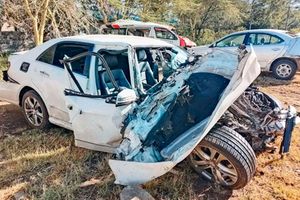Premium
Dairy farming is never all about production of milk

The calf from Kiambu County when it was taken to Murang’a County for rehabilitation. The body condition improved with proper feeding and deworming.
Sometime back, I informed you I was embarking on rearing cattle. I had always avoided farming livestock due to heavy work and parenting engagements. Many of my clients asked why I could not keep even one cow for my family milk.
My answer was always that it was cheaper for me to buy than produce milk.
Honestly, many people producing milk, eggs and the occasional goat or sheep meat should not be throwing their hard-earned cash in that direction. They would be better off buying the food.
Two main reasons people expensively produce their food, whether crop or animal-based, is that they never do the input-output maths or they are sentimental about farming because they were brought up on farms.
Anyway, I started my venture that I would not call dairy farming. But I work with dairy cattle. My model is to acquire animals in poor body condition, rehabilitate them and inseminate and sell them to those who wish to produce milk.
Most farmers I meet are akin to many contemporary young people. They want the best without putting in the best or not knowing what the best input required is.
I recall this young woman I met at my house visiting with my children. We discussed marriage when she told me she was searching for Mr Right.
I was interested in her specifications. The woman said it should be a man in his late 20s to early 30s, understanding and financially stable, “with a good car and good house in a leafy neighbourhood”.
I cautioned her that I identified with the age specification but the asset requirements sounded more like for my agemates.
I meet many farmers with similar wish-to-reality specifications for the cattle they would like to have.
Many say they want high-producing dairy cattle that are easy to manage, feed and maintain the body condition but without understanding the work that accompanies such animals.
I have seen people buy high-yielding cows that get to their farms but milk suddenly goes on leave. I recall one who bought cows from Nakuru that produced 30 litres each in his presence the day before departure.
The cows looked shiny, happy and had smooth hair with the trademark beautiful Friesian black and white coat colour.
They appeared confident, bright and happy.
A week later on his farm in Nairobi, the cows could hardly produce five litres of milk a day.
Some dried up while others became discoloured, dirty and with thin long and curled hair within a month. The coat also started turning brownish in the black areas. It was a case of poor management and nutrition.
When I advised the farmer on the proper nutrition and management of Friesian cattle, he opted to sell them and abandon dairy farming. It was a wise decision because I was certain he was going to lose the animals to malnutrition and starvation.
Starvation is food deprivation – when animals get little or no food for long periods. Malnutrition is feeding of a ration that is not balanced in carbohydrates, proteins, minerals, vitamins and water.
Starvation and malnutrition are detrimental to milk production and the body condition of dairy cattle.
Most farmers keep dairy cattle for milk, replacement stock, wealth creation, prestige and manure.
My model is mainly for wealth creation, farmer education and manure. In practising veterinary medicine, I have come to conclude that most cattle in zero grazing production are perpetually malnourished and starved.
The situation is especially bad for the young stock comprising weaners, growing and bulling heifers. My strategy is to buy animals in poor body condition, rehabilitate and inseminate them before selling them off in-calf.
I make money with the value of a better body condition, increase in growth, being in-calf with good semen and the manure produced. In the process of rehabilitation, I train farmers that a good dairy animal is defined by genetics, management, feeding and breeding.
Two weeks ago, I teamed up with Zack, a paravet from Kiambu, to scout for candidate cattle for my project. I needed 10 heifers between four and 12 months old and in poor body condition.
We scaled a large part of Kiambu searching for the animals, only to realise people from other counties were doing the same in the area. We met scouts from Nakuru, Kericho and Nandi.
After a two-week search, we obtained 10 heifers. Eight were Friesian and two Ayrshire that had been sired by artificial insemination. I prefer not to buy dairy stock sired through mounting because one can never tell the genetic quality of the bull.
True to the zero-grazing notoriety, the animals were in very poor body condition. They were consolidated at a farm in Muguga from where we transported them to Murang’a.
Before departure, I injected them with an antibiotic to prevent transit fever.
Once on my farm, I dewormed them, installed identification ear tags, washed them against ticks with acaricide and placed them on a feeding programme with super napier among other feeds. They loved the super napier; which none had eaten before.
I also vaccinated the animals against anthrax and black quarter. A local who saw them asked why I did not know how to select good animals.
I told him that I had just rescued the animals from Shakahola, in reference to the trending human starvation catastrophe in Kilifi County.
The farmer understood my sarcasm and said he looked forward to seeing the animals transformed.





